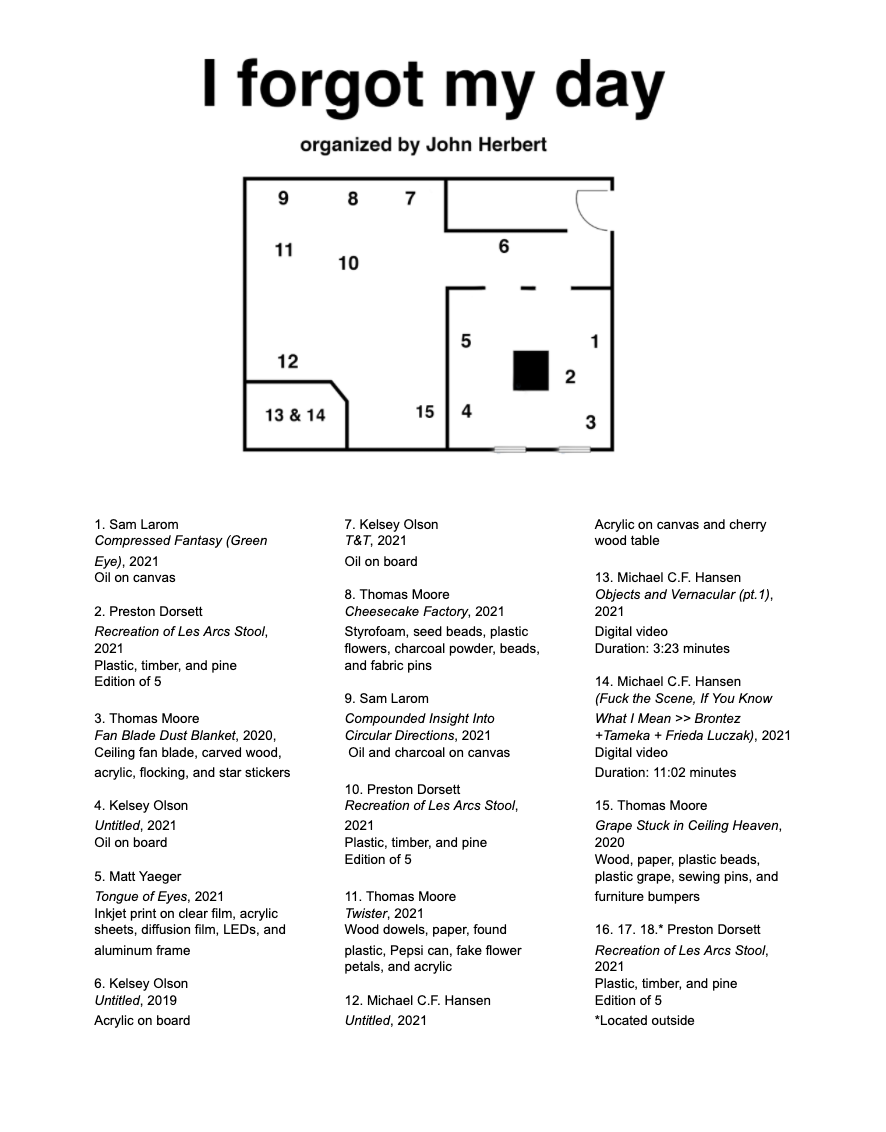 On a Summer day in 2018, I noticed a letter taped to the front door of my apartment from one neighbor addressed to another whose contents I think about often. The frontal facing page read, “Dear Neighbor Lady, I apologize for not getting back to you this A.M. with the jumper cables as promised… Most days I feel like Drew Barrymoore in the movie 50 1st Dates!!! Please contact me if you would like to perhaps join me for a cup of coffee and I would like to get to know my…” with the remainder of the letter cut off from the ellipses. While not personally addressed to myself, this note adhered to a piece of pink construction paper has stuck with me ever since my discovery of it as an abstract on the beauty of time, forgetting, and memory. From this remorseful invitation to a cup of coffee from one neighbor to another, regardless of the outcome of the event described in the letter, an impact of connection between two strangers was made, and ultimately, initiated by a neglect towards memory.
On a Summer day in 2018, I noticed a letter taped to the front door of my apartment from one neighbor addressed to another whose contents I think about often. The frontal facing page read, “Dear Neighbor Lady, I apologize for not getting back to you this A.M. with the jumper cables as promised… Most days I feel like Drew Barrymoore in the movie 50 1st Dates!!! Please contact me if you would like to perhaps join me for a cup of coffee and I would like to get to know my…” with the remainder of the letter cut off from the ellipses. While not personally addressed to myself, this note adhered to a piece of pink construction paper has stuck with me ever since my discovery of it as an abstract on the beauty of time, forgetting, and memory. From this remorseful invitation to a cup of coffee from one neighbor to another, regardless of the outcome of the event described in the letter, an impact of connection between two strangers was made, and ultimately, initiated by a neglect towards memory.In July of 1937, an abnormally large three-pronged footprint was found impressed into the sand of a beach in Coatue, a small town located on the island of Nantucket. Its discovery generated mass excitement and curious fear amidst the community, as sightings of oceanic monsters had been found on several occasions by people in the area earlier in the season and years prior. Days after the discovery of the mysterious footstep, a local fisherman spotted a colossal one hundred twenty foot spike-spined mass that hovered above the water. Local news outlets reported on the matter, which generated an interest so great that the story of the unknown beast was pursued further by media corporations across the country. The mass hysteria was drawn to a close one Summer morning when the monster was found beached on the shore. Much to the surprise of the community—but not that of the scientific community investigating the situation—the elusive creature was not a prehistoric amphibian whatsoever, but a Macy’s Thanksgiving Day Parade balloon, filled with nine thousand pounds of compressed air. These shocking moments were masterminded over several months by the American puppeteer Tony Sarg. His use of the twenty-six fanged rubber serpent proved to be the spectacle of the Summer. What began as a fear of the unknown quickly escalated into a confrontation of past and future fabled beings. A worldwide publicity stunt, concocted by Sarg, incited joy, heirloom family photographs, and shared public wonder amongst the local community and the world watching. Albeit Sarg’s serpent situates itself as only one microcosmic component in history stemming past that point in July of 1937, it's folkloric and unbelievable personality becomes nostalgic for the people who partook in its happening, alongside the people who are only present in its happening through its archived documentation.
“I forgot my day” stands as a chronicling of engagement with these magical acts. A nostalgic importance is set on the memorable but history-stricken outcomes of navigating the world through shared yet unfamiliar moments similar to witnessing Sarg’s beached serpent or meeting a neighbor over coffee. The participating artists in “I forgot my day” examine the intimate yet impersonal nature of humanity. Throughout the exhibition are referential interactions and less literal imagined confrontations with time. The artists present us with feelings of humor, nostalgia, and nothingness which become harmoniously woven into homeroom’s encapsulating basement space and history.
Thomas Moore’s Grape stuck in ceiling heaven (2020) portrays a miniature scale view of an inverted ceiling, proposing the viewers with a question of, “What if your surroundings were flipped upside down?” His dissection of how space and dreams function in reality are testing the limits of what a space and its memory are capable of when twisted and anatomized. In the same vein of analysis on memory illusion, Moore’s work initiates a conversation with the paintings from Kelsey Olson. T&T (2021), depicts a realistic view into Olson’s Minneapolis studio. Its title is a direct reference to an auto repair shop in Northeast Minneapolis of the same name. The image centers on a miniature wooden model of the auto repair shop surrounded by studio tools and personal trinkets. Olson’s Trompe-l'œil technique renders materials to alter the recollection of the auto body shop it honors; this painting documents a seemingly unreal (but real) place. The use of materials by each artist maneuvers one’s perspective on dimension, both Moore and Olson work to appreciate the oddities and comfort of tangible space.
The criticism and survey of nostalgia are defining elements of Michael C.F. Hansen’s and Preston Dorsett’s work. C.F. Hansen utilizes digital video and painting to direct a stream of consciousness breakdown of an idealized Midwestern life. He colorfully composes an amalgamation of imagery taken from zoos, religious symbolism, small towns, influential music, and graphic design. An orchestration of abstract references visually present themselves in composition, creating a consistent tempo in each of his video works. Symbols rapidly spiral across the monitor, alluding to his passion towards animal rights in conjunction with the typical social ephemera associated with the American Midwestern mentality. Across from C.F. Hansen’s painting, Untitled (2021), sits one of five stools made by Preston Dorsett. Dorsett’s Recreation of Les Arcs Stool (2021) is critical of similar social and historical cues to those of C.F. Hansen, but are guided by issues of historical classism and accessibility. Initially designed by French architect Charlotte Perriand, Dorsett alters its originally intended opulence by recreating five stools from discount lumber and black plastic paint. This altering of material sheds light on the stool’s immediate function and its historical use as an emblem of affluence. Both Dorsett and C.F. Hansen utilize appropriation in order to initiate the recontextualization of an object or symbol.
Compressed Fantasy (Green Eye) (2021) by Sam Larom leads the viewer through boldly colored abstractions divided into quadrants. Located in the upper right quadrant of Larom’s six foot tall canvas sits a mark discernible as a caricature of a cartoon eye. The other three quadrants depict fragments of hard lines and strikes of bold swoops, directing the viewer back to the comfort of recognized imagery in the aforementioned quadrant. Larom uses abstraction as a way to create associations to the identifiable. Like Larom, Matt Yaeger’s scanned image titled Tongue of Eyes (2021) employs abstraction to comment on the fracturing of the body and imagery found in digital stimuli. Text bubbles, emoticons, and bodily forms are shown under an LED scanner-bed-like green lit frame in Tongue of Eyes (2021). These demarcations of conversation smokily chronicle instances of physical interaction to inform digital dialogue. Forgetfulness is set into Larom and Yaeger’s work by splitting up and zoning in on real world experience in order to become a contemporary tool for remembering.
“I forgot my day” is a sum of these instances where humankind forgets aspects of itself and all that it surrounds to make new meanings of humanity. An exhibition held in a century old structure imbued with memory, the works included in the exhibition lend an appreciative hand to the un-momentous of the everyday and imagined, noting that the magic behind the unmonumental is paradoxically monumental. The artists uniquely identify the degrees in which forgetfulness of the past, present, and future create the remembered facets of humanity through a myriad of executions.
I forgot my day
by John Herbert
Featuring
Preston Dorsett (He/Him) is a designer living and working in Minneapolis, Minnesota. He is currently positioned between the worlds of furniture making at Concrete Pig and city planning at Juxtaposition Arts. These two perspectives exist in his artistic work as simultaneous experimentations of material fabrication and social study. His current effort is to explore the failures and successes of the European Midcentury Modernists by bootlegging their highly valued original designs.
Michael C.F. Hansen (He/Him) is an interdisciplinary artist living and working in Minneapolis, Minnesota. Primarily focusing on videography, he earned his BFA in New Genres from the San Francisco Art Institute (’19).
Sam Larom (He/Him) is a South Korean born painter who received his BFA from the Minneapolis College of Art and Design in 2019. Currently, he lives and works in Minneapolis, Minnesota.
Thomas Moore (He/Him) is a Chicago, Illinois based artist from Columbus, Ohio. Moore’s work is referential to the fantasies which accrue from a personal visual lexicon of idealized Midwestern dreamscapes, similar to parking garages, convention centers, and malls. Moore’s work regards the effects dreams have on these remembered and invented landscapes, oftentimes exaggerating the purpose of scale and personality of space as a reaction to how these purposes might shift seamlessly during a dream. Another point of interest within these works are the fictitious paths and environments created for a point-and-click game character's pursuit of a goal which lays out a destiny before the adventure takes place, proving the landscape’s impact upon the individual.
Kelsey Olson (She/Her) is an artist that makes paintings and photo process works. She received her BFA from the Minneapolis College of Art and Design in 2010 and was a recipient of the 2016-17 Jerome Emerging Artists Fellowship. She has participated in group and solo exhibitions throughout Minneapolis and Minnesota, including at the Rochester Art Center and St. Cloud State University. Olson is from Montana and lives in Minneapolis.
Matt Yaeger (He/Him) is a Minneapolis artist who works in painting, print and sculpture. His work explores aspects of digital social culture framed within science fiction narratives. He is interested in how the abstract space of text messages, DMs, news feeds, and other forms of digital consumption become psychologically and emotionally pervasive, shaping how we think, feel, and live.
